Physical Address
304 North Cardinal St.
Dorchester Center, MA 02124
Symptomatic cartilage defect in a young patient is a difficult problem to treat. Several options for biologic treatment have been described, but each of them has its own limitations. For example, the use of cylindrical allograft transplants (single plug, snowman technique), which is a well-established technique for focal chondral defects, has shown good results in carefully selected patients. However, it is restricted to small-size cartilage defects. Residual defects and surface discontinuity are other problems associated with this technique.
After the failure of cartilage repair, substitution, or replacement, arthroplasty remains the inevitable treatment for these patients. There is no doubt that joint replacement surgery has shown excellent results in elderly patients. Nonetheless, it is a less favorable solution in younger patients, who tend to experience reduced implant longevity, and therefore subsequent revision surgeries are often required.
Hence, in young patients with large cartilage defects and as an alternative to the procedures mentioned earlier, the fresh large osteochondral shell allograft transplantation (FLOCSAT) concept has been described as a potential solution in this cohort of patients, with encouraging early results. This chapter discusses the biologic basis, the challenges, and the surgical techniques of using osteochondral allograft.
Certain tissue types of mammals (e.g., skin, liver, kidney, lung, brain) heal with collagenous scars, whereas others (e.g., bone, tendon, synovial membrane) heal with tissue corresponding to the parent tissue without a significant loss of function. In both cases, it is a cellular repair process in which fibroblasts or tissue-specific cells (osteoblasts, chondroblasts) synthesize the required substances and structures. This is usually done by new cells that arise in the context of cell proliferation and modulation of locally existing cells, by cells from the edge of the lesion, or by cells that migrate through the blood vessels into the tissue. Both repair processes are characterized by cell division requiring DNA replication. Whereas chondrocytes from immature cartilage are capable of miotic activity and cell division, mature chondrocytes have limited replication capacity.
Because intact cartilage lacks vascularity, the access to chondral progenitor cells for the repair process is missing. This allows only repair with scar tissue and fibrous cartilage. This repair cartilage integrates poorly into the surrounding normal cartilage tissue and may therefore be responsible for the development of osteoarthritic changes over time ( Fig. 73.1 ).
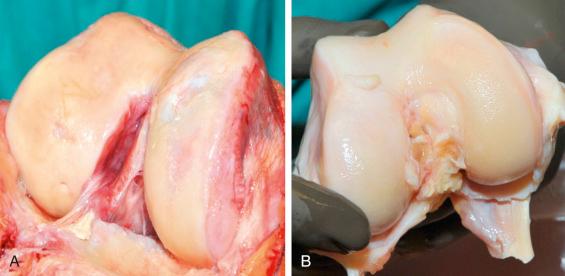
Large symptomatic focal chondral or osteochondral defects have a strong negative impact on the quality of life. This is not only limited to sports or impact activities but also applies to the accomplishment of normal daily activities. Patients with articular cartilage defects of the knee have shown low quality-of-life scores (Knee Injury and Osteoarthritis Outcome Score [KOOS]), which were comparable to preoperative scores for patients selected for knee arthroplasty or high tibial osteotomy (HTO) for severe osteoarthritis. This is even a more significant problem in young patients, where knee arthroplasty is not an ideal treatment option in terms of patient satisfaction and/or due to problems related to the potential need for future revision surgeries.
There are several treatment options available for treating idiopathic or traumatic focal chondral lesions. Examples of these are microfracturing (MF), autologous chondrocyte transplantation (ACT), and autologous matrix-based chondrogenesis (AMIC). However, they are less suitable for large subchondral lesions, missing intact cartilaginous margins, opposite (“kissing”) lesions, or large bone defects. The resulting cartilaginous tissue is not that of a full-bodied hyaline cartilage, and the reported clinical outcome is generally poor. Hence, FLOCSAT may represent the only current biologic therapy for failed cell-based surgery or autologous mosaic plastic surgery.
Modern arthroplasty shows excellent results in the elderly patient. On the other hand, joint replacement surgery has shown significantly shorter implant lifetime in younger patients, and more frequent revision surgeries are usually required. These subsequent surgeries are associated with increased complexity, constant reduction of the available bone stock, diminished range of motion, and decreased mobility.
Modern arthroplasty shows excellent results in elderly patients. However, it has significantly shorter lifetimes in young patients, and subsequent revision operations are more often required.
The FLOCSAT concept was described for the young patient with a destroyed joint as an alternative to total joint replacement.
The first human joint transplants were described in 1908 by Judet and Lexer. Their attempts were followed by those of Volkov, who described in 1970 unsatisfactory overall results after transplantation of whole joints. These attempts were associated with incomplete vascularization, graft micro-fractures, graft disintegration, and graft failure. The high complication rate and problems with the mechanical integrity of the grafts were mostly attributed to the lack of vascularization.
The analysis of large-volume free allogeneic transplants from recipient patients showed that although considerable absorption takes place, osteointegration may still occur in the peripheral contact areas ( Fig. 73.2 ). Thus arises the question of whether an improved vascular connection between the recipient bed and the graft can reduce the graft resorption and improve its osteointegration as well as the nutrition of the cartilage tissue and contribute to improved overall results.
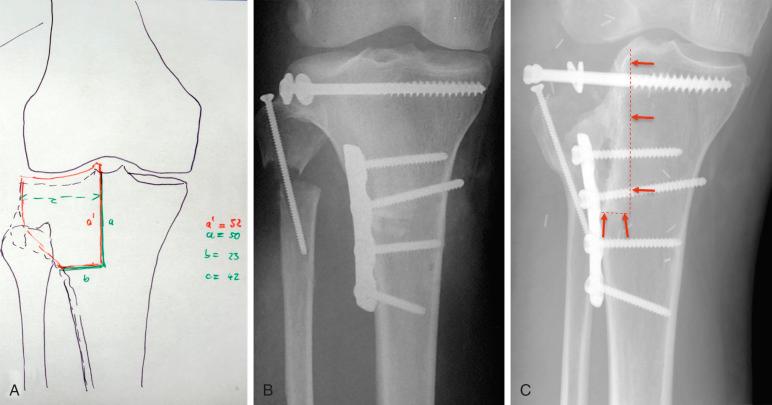
Animal experiments with whole vascularized knee joints show a significant immune response that can be affected by immunosuppression in various forms. Therefore the results of this transplantation approach were unsatisfactory in many aspects. Cartilage destruction developed with failure of the vascular anastomoses, and both of these two elements were attributed to chronic rejection.
A similar experience was observed in humans, where the transplantation of human donor joints with a vascular pedicle (ABO system compatible, human leukocyte antigen [HLA] system mismatch) showed, despite the use of immunosuppressive drugs (cyclosporine, azathioprine), severe acute and chronic rejection crises.
The first reported series of five vascularized joint transplants revealed significant problems, such as severe contracture, infection, and multiple revision surgeries, including arthrodesis and subsequent amputation in three cases. However, interestingly, one case from the same series had a 4-year survival at the time of the report. Despite that, the case was complicated by a severe rejection crisis 2 years after transplantation, but it was successfully treated with high-dose steroid therapy. At 4 years, satisfactory knee mobility under full load was reported. Since then, there have been no further publications on the long-term follow-up of these cases.
The principle of transplantation of fresh osteochondral autografts (OCAs) is the transfer of vital cartilage tissue while maintaining its metabolic activity and preserving the surrounding matrix, with the aim of an intact, geometrically accurate structural and functional osteochondral unit for the replacement of damaged chondral articular surfaces. In other words, the hyaline cartilage is transferred to the defect as a vital cartilage–cell–tissue composite on a bone layer. The procedure has the advantage of early loading capacity, but quickly reaches its limits (incongruity and gaps) in the case of larger defects and the need for multiple transplants (snowman technique; Fig. 73.3 ).

The problem of limited availability of autologous graft tissue for the application of cylindrical grafts can be circumvented by the use of allogeneic osteochondral tissue. This can be used to accurately replace large-area cartilage defects or combined bone–cartilage defects, most of which arise as a result of osteonecrosis and trauma, among other causes. However, immunologic reaction and the limited availability of the grafts are the main challenges here.
In recent years, the use of allograft transplantation in some centers in the United States and Italy has been extended to the restoration of completely destroyed joints, with the aims of pain reduction, improvement of joint function, better quality of life, and avoidance of or at least delay in the use of joint arthroplasty. In young patients with large cartilage defects, transplantation of fresh osteochondral allografts is currently considered the only biologic joint-preserving treatment after failure of regenerative procedures.
Based on the preliminary work of Bugbee, Giannini, Stannard, and Cook, the FLOCSAT concept was developed. It involves the transplantation of thin fresh osteochondral joint segments (ideal thickness, 6 to 8 mm) to provide a geometrically gap-free graft–host bone interface ( Fig. 73.4 ). The dimensions of the bony base layer are dictated by the minimal thickness of the bony tissue that can provide a secure fixation of the graft to the recipient bed. The fixation is usually performed using Kirschner wires (K-wires) or screws. Choosing an optimum geometrical configuration of the graft can help provide press-fit fixation. This can also limit or dispense the fixation with implants.
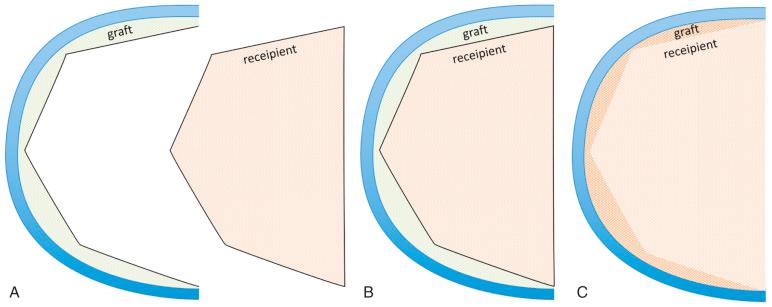
The transplantation of a single joint compartment or even complete joints can be more beneficial than a limited graft. This is because it has fewer problems with size matching and fitting and can overcome any possibly existing ligamentous and/or meniscal defect.
The FLOCSAT concept has been described for the young patient with a destroyed joint as an alternative to total joint replacement.
In the FLOCSAT concept, fresh, large osteochondral allografts with a low bone layer thickness are transplanted.
The use of osteochondral allograft in clinical practice has several challenges. First, there is a limited availability of donors from which fresh living osteochondral tissue can be obtained. Second, there is a relatively short time frame for transplantation to be completed. Third, there are several administrative and logistic obstacles that can slow down or even stop the process. This also includes the extensive medical-legal requirements. Finally, the procedure of graft preparation requires complex surgical techniques.
There is a large variety of legal conditions under which transplantation of allogenic tissue can be performed. In the United States, it has been possible since the 1990s to commercially acquire OCAs from certified tissue banks after the American Association of Tissue Banks issued mandatory guidelines for sampling, storage, and processing under the supervision of the US Food and Drug Administration (FDA).
In our own institution (Hannover Medical School [MHH]), the entire process consists of obtaining the joint tissue, storage, preparation, and application to the patient and is the responsibility of the first author according to Section 20d German Arzneimittelgesetz (AMG). This law allows an exemption from the standard procedure and only applies if the physician performs the previously listed activities in person.
OCA tissue should be harvested within 24 hours of donor cardiovascular death (multiorgan donor, postmortem donation), ideally from healthy young donors ages 18 to 60 years with a history suggesting intact cartilage and/or macroscopically and anatomically intact cartilage.
The storage conditions have implications for chondrocyte vitality, mechanical properties, and time to transplantation. Various storage conditions have been described using different media (e.g., saline solutions, serums), various temperatures (frozen, cryopreserved, room temperature, body temperature), gas partial pressure (N 2 proportion), and nutrient solution management (± media change). In our protocol, a storage temperature of 4°C and a 28-day window was shown to maintain a critical chondrocyte survival rate of greater than 70% ( Figs. 73.5 and 73.6 ).
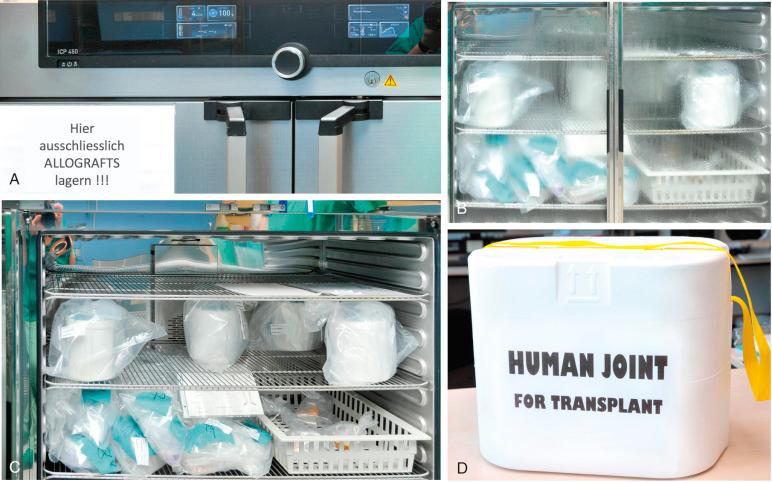
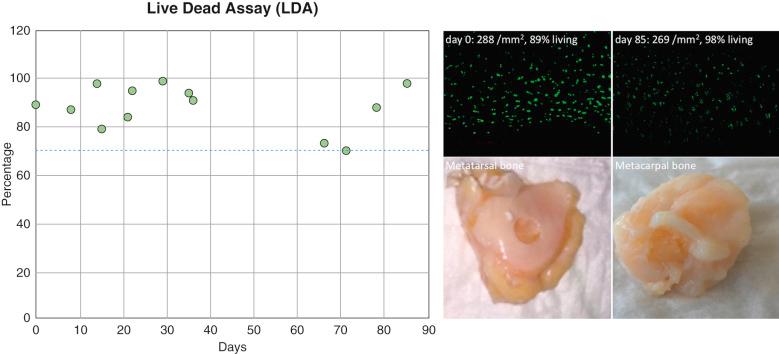
Become a Clinical Tree membership for Full access and enjoy Unlimited articles
If you are a member. Log in here